In May 19, a Taliban assault force employing suicide bombers, rocket-propelled grenades, and small-arms fire attacked Bagram Airfield, Afghanistan, just before dawn, killing a contractor and wounding nine over the course of an eight-hour firefight.
Airmen with the 455th Expeditionary Security Forces Squadron and other service members engaged attackers at several points along the base’s perimeter fence, killing about 12 attackers—including four intended suicide bombers—preventing penetration of Bagram’s perimeter.
The attack was a stunning reminder that the Air Force may not be challenged in the skies over today’s war zones, but that does not mean airpower is free to operate at will.
Air Force assets are forward deployed in a host of Southwest Asian nations to support the wars in Iraq and Afghanistan. Aircraft ranging from aerial tankers to fighters and intelligence-surveillance-reconnaissance assets are at facilities and forward operating areas often located in the middle of combat zones. The Air Force’s force protection practices have consequently evolved—and quickly—to meet a combination of traditional and nontraditional threats.
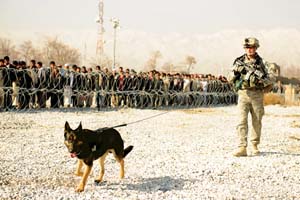 |
|
USAF officials have spent the better part of the last decade figuring out how to protect forces and assets around a battlefield with no front lines. The threats are often elusive, from isolated car bombs and mortar fire to coordinated small-team assaults. Officials must even be wary of the occasional large strike with heavy weapons. One thing is clear: This is not Cold War-style garrison force protection.
Hard Lessons Outside the Wire
“There is a massive, massive difference,” he said, of force protection activities and tactics after nine years of combat. “The warrior skills … just to get into these mission sets now … have changed dramatically. We never would have dreamed of this type of stuff in the Cold War.”
During the Vietnam War, the Air Force learned hard lessons about defending its bases using “outside the wire” operations, senior USAF force protection officials note. For the most part, however, the tactics and practices honed in Southeast Asia slowly eroded as the US reoriented its base defense posture toward traditional Cold War threats.
Tactical level is just one piece of a broad portfolio of potential threats that range from cyber intrusion to ballistic missiles.
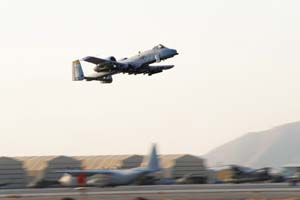 |
|
One of the largest hurdles the service has faced in recent years is the effort to integrate and standardize a joint approach to base defense, while redeveloping the ability to operate outside the wire, noted Brig. Gen. Jimmy E. McMillian, director of security forces in the Air Staff’s logistics, installations, and mission support division. But in this time, he added, many changes in security forces doctrine, concepts, and practices originated in the USAF security forces community—and have since become standard practice across DOD.
“The basic principles of base defense are essentially the same, regardless of where an installation is physically located,” McMillian said. New concepts to evaluate risk to facilities have developed over the last several years to give installation commanders the most flexibility to address their own unique threats at any given time or place—with the intent of increasing an installation’s ability to detect, deny, and respond to threats within its immediate area, but as far away from the “operational resources” as possible.
“Our objective, in all cases, is uninterrupted operations,” McMillian said. In some locations, this means uninterrupted aircraft sortie generation, in others, uninterrupted training activity.
Since 9/11, Air Force security forces personnel have often been face-to-face in battle with terrorists and militants in Iraq and Afghanistan—from augmenting convoys to running ambushes on rocket and mortar teams threatening bases, to being involved with and securing zones for medical evacuation.
As a result, the SF field is one of the hardest hit in the Air Force. Several of Decknick’s fellow SF airmen have been killed in the line of duty since 2001, and many more wounded facing sniper attacks, roadside bombs, and other threats.
“Not only has the training changed, the deployment time has changed,” he said.
Airmen confronting threats to air bases and joint facilities are often now operating with Army, Navy, and Marine Corps personnel, he said, as the nature of the war has pushed base defense into a different concept of operations. “It’s no longer ‘OK, Air Force. Go out and guard Joint Base Balad [Iraq], and have a good day,’ ” Decknick said.
While the Air Force’s assets are not challenged in the skies in Southwest Asia today by enemy aircraft, the asymmetric advantage of airpower is all too apparent to militants in Afghanistan. In response, Taliban and al Qaeda forces continue to launch brazen attacks on US air hubs, such as this year’s strike at Bagram.
The defenders’ efficient response there averted a potential “spectacular event,” according to Combined Joint Task Force-82 officials. “The quick defensive reaction by the Bagram security forces likely saved a lot of lives,” said Army Lt. Col. Clarence Count Jr., spokesman for CJTF-82.
Three days later, Kandahar Airfield—the main air hub in the country’s south—came under rocket attack, and in a similar manner, an element of Taliban fighters attacked the north side of the base only to be repelled by security forces.
These attacks, and the subsequent responses, revealed the interwoven nature of base defense in a combat theater today. Decknick noted that members of all services were eventually caught up in the response.
“No longer can any base just be secured from the fence line in,” he said. “You have to integrate the indirect fire footprint, the approach and departure ends of the runway, the surface-to-air fire footprint. … You have to integrate 10 clicks out with whomever owns that battlespace.”
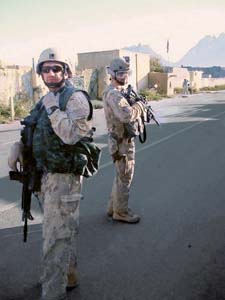 |
|
As much coordination with other combat elements—such as units conducting counterinsurgency missions, medical evacuation flights, or even transporting goods and equipment to and from the base—is involved in daily force protection activities for most SF units in US Central Command, he added.
“You get approval from the people who own that ground: … In the case of Balad, even now, soon it could be the Iraqis,” Decknick said. “You deny the enemy that territory and create free lines of communications.”
Lines of Communication When it comes to protecting bases, the lines of communications run to and from the theater commander, he added. Decknick has a counterpart who works at the combined air and space operations center for Southwest Asia, coordinating and sharing information on threats to bases in his theater, but the information must go both ways.
Lt. Gen. Gilmary Michael Hostage III, the AFCENT commander, “expects me to push [information] up,” Decknick said. “Commanders on the ground have a greater grasp of tactical threats and what’s going on in their location. There’s a lot of information sharing going on.”
McMillian said the Air Force now models its approach on joint DOD security operations concepts, which revolve around the METT-T framework—that is, mission, enemy, terrain and weather, troops and support available for security operations, and time available. Looking at these factors, a tactical analysis is establishing a base boundary line—but not necessarily a traditional one.
A tactical boundary, as informed by operations in Iraq and Afghanistan in large part, is a line where an installation commander may deploy and use force. In Southwest Asia, this line is often located outside the perimeter fence. Since the advent of Operation Desert Safeside in 2005 in and around Balad, Iraq, this change in policy has moved Air Force SF personnel into close proximity with threats far from base gates.
The result of moving force protection activities farther afield from a base is closer coordination with commanders in the immediate environment—often Army and ground component commanders in Iraq and Afghanistan.
Despite the nontraditional nature of the threats to bases in Southwest Asia, the Air Force recognizes some vulnerabilities are the same in all operational environments.
The preferred method of attack against air bases historically has been through standoff weapons such as rockets and mortars, McMillian noted. To better plan for base defense, USAF developed the base security zone construct, identifying an area from which an enemy can launch an attack on the personnel and resources at a given location or aircraft departing and approaching the installation.
Because of the persistence of these types of threats, and due to the integrated nature of defending bases, McMillian said the Air Force took the complementary measure of setting up the Integrated Defense Risk Management Process (known as IDRMP) at the installation level across the force. This combines the decision-making process each commander must follow with the intelligence element of each installation and area and the relative risk.
The result of this policy change is moving installation security from a process more associated with compliance standards to capabilities-based effects and standards to confront threats. Information sharing, between theater commanders, local commanders, and other stakeholders near the location, as Decknick notes, is crucial to success.
In addition to policy changes, the Air Force has aligned specialized tracks in its training regimes, with base security operations focusing on inside the wire needs, area security for outside the wire scenarios, and other specialties. Each track includes specific field training exercises and collective skills exercises.
Critical to the success of proper force protection and base defense activities, McMillian said, is the establishment and improvement of a feedback loop. This turns “lessons identified” into “lessons learned” to incorporate changes into training curricula and lesson plans as quickly as possible. Speed is critical so that security forces can evolve with threats.
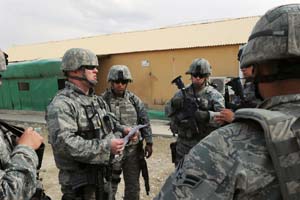 |
|
One method of keeping force protection activities up-to-date is sending deployed security forces members to regional training centers to give current perspectives on a location. The Air Force also rotates instructors into Southwest Asia to keep expertise and the curriculum relevant to the actual threats facing each base and theater.
Real-time information on threats has proved critical in operations at the tactical and theater level as well, McMillian said. It is an “absolute necessity” for successful operations in deployed locations, fixed bases abroad, and in protecting Air Force installations at home.
For his part, Decknick believes the lessons learned and tools honed in securing facilities in Iraq and Afghanistan apply in other theaters. “I think this is a revolution in military affairs. … Everyone is a piece of [this],” he said. “This concept applies in Africa, in [the Pacific].”
The Air Force is seeking to improve threat detection and push enemies as far away from airmen and resources as possible, noted McMillian. The process has helped improve DOD-wide standards.
The Air Force led the way in requiring 100 percent of entry-control identification credentials to be physically and visually inspected at installation perimeter entry points, for example. This is now standard practice across the department.
Tailoring TASS USAF also began 100 percent inspection of large commercial vehicles at installation entry points, with the same goal of keeping potential threats from the troops and equipment.
Not only are tactics and training evolving with threats, the tools to keep airmen and facilities secure are constantly improving as well, said officials with USAF’s force protection programs office at Hanscom AFB, Mass.
“A lot of what we’re doing is the [integration] part. … There’s a lot of information out there, and a lot of it is stovepiped, and we’re trying to bring it together,” said Roy Higgins, the force protection programs joint projects manager at Hanscom. Higgins notes that much of what acquisition programs focus on in the base defense field is command and control and melding architectures for communicating data—be it access-control protocols or sensor information. “How do you share information from Hanscom, for example, with other bases and services?” Higgins asked rhetorically.
Since 1996, the force protection programs office at Hanscom has managed and upgraded TASS, the Tactical Automated Security System, a deployable integrated electronic security system that provides a tailor-made security footprint to a given location, said Patrick Dagle, chief of force protection programs at the base. In use across the globe in various configurations, its biggest user is AFCENT.
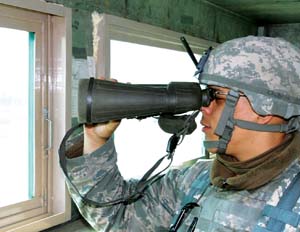 |
|
TASS uses various sensors, cameras, radars, thermal imagers, unmanned aerial vehicles, and other tools at numerous locations across the theater to collect and disseminate a range of threat information to the installation and theater commanders. Versions of TASS are in use around the world, Dagle said, as the program can be tailored to the particular environment of each location and takes little time to set up.
Integrating different capabilities and creating familiar operating tools is key in war zones, numerous officials said. If Air Force security forces airmen leave a post in Iraq, Dagle said, they could very well be backfilled by ground troops. DOD needs to ensure images from an Air Force sensor can be transmitted to a Marine Corps laptop or displayed on an Army screen.
Combined operations will be the norm in combat zones, so integration must go beyond security. Under one demonstration effort under way, the force protection office is looking at how to tie different pieces of the base together, from the fire department to the chemical, biological, radiological, and nuclear response elements and other first responders. It’s important for all these people to have a common operations picture, through better, more accessible, and interoperable command and control and ISR, he said.
“This particular teaming scenario, where everyone is in it together, … applies for the future of our military and our government,” Decknick said. “It really does take a flipping village these days,” he added with a laugh.